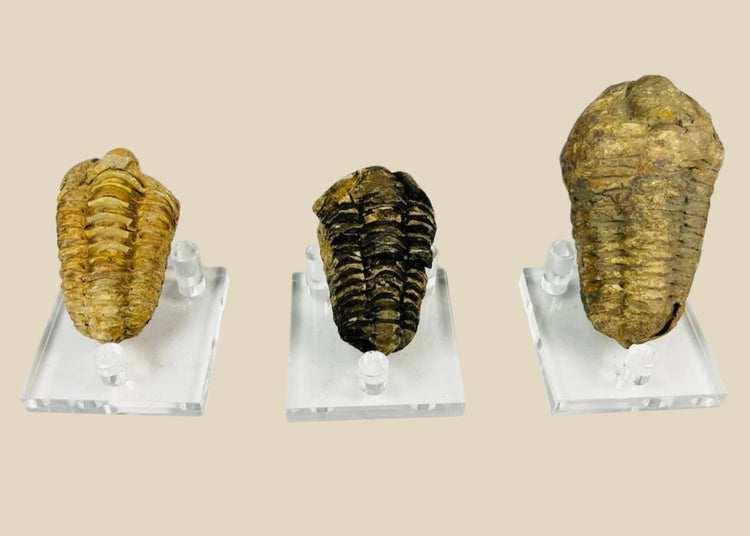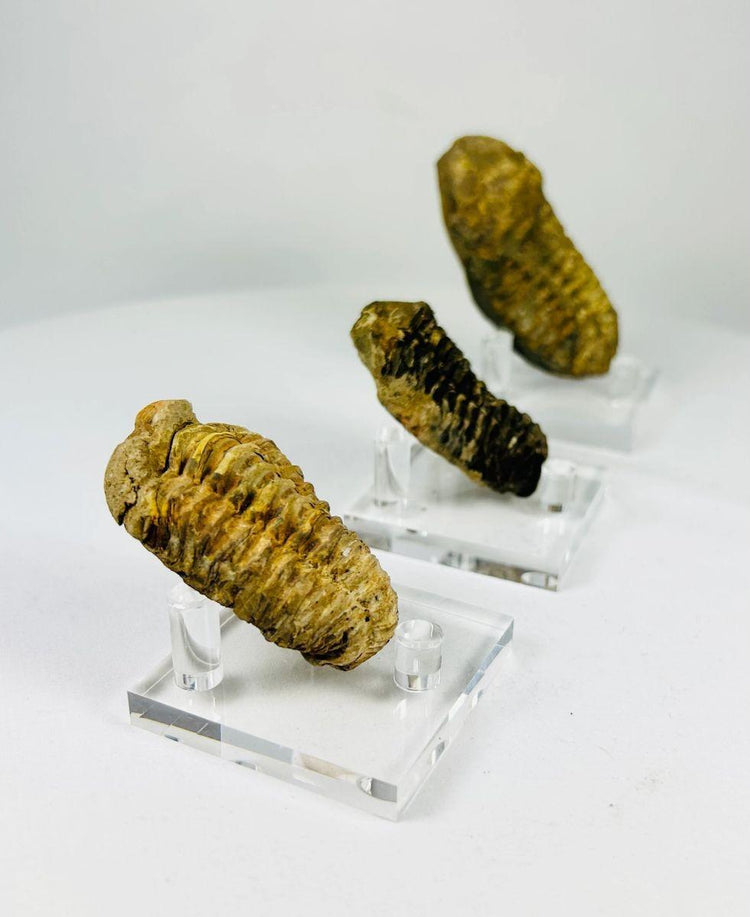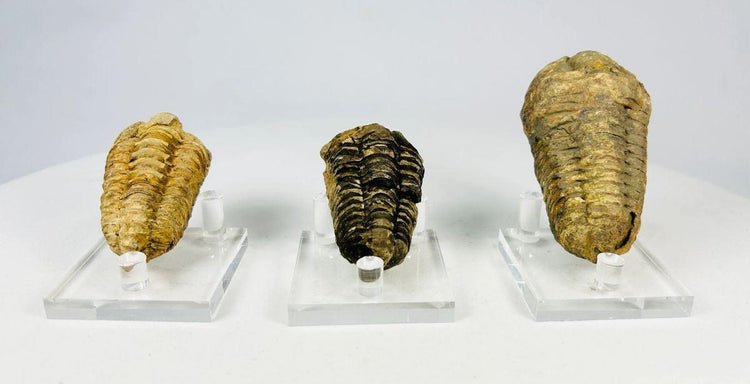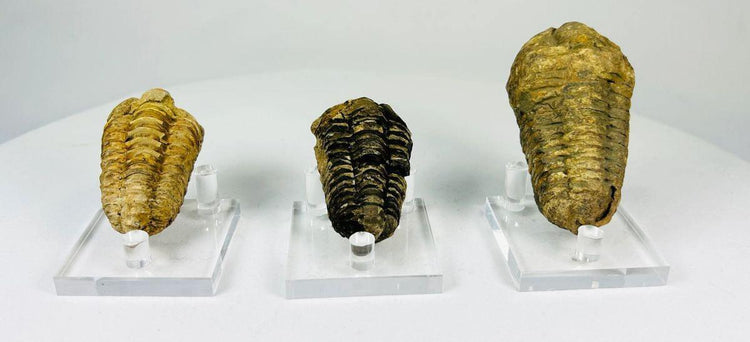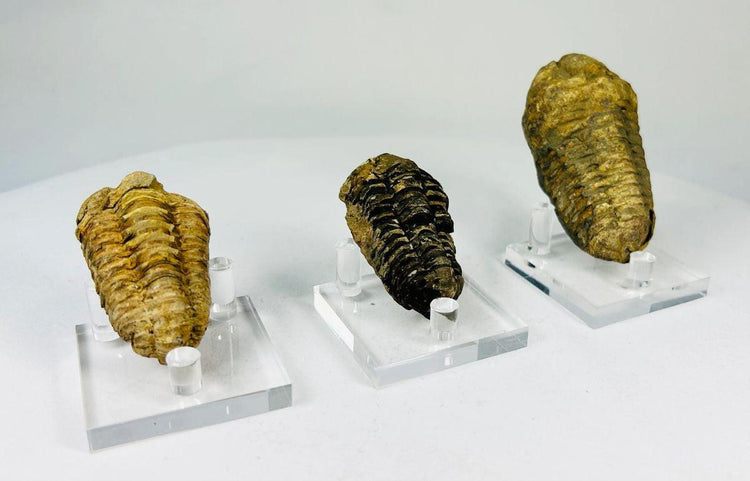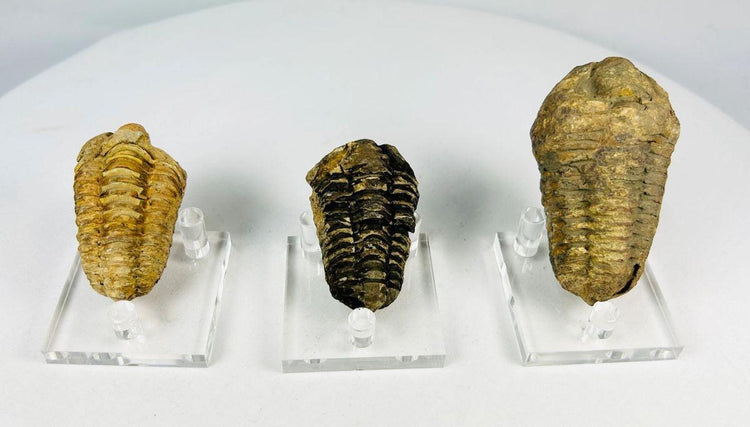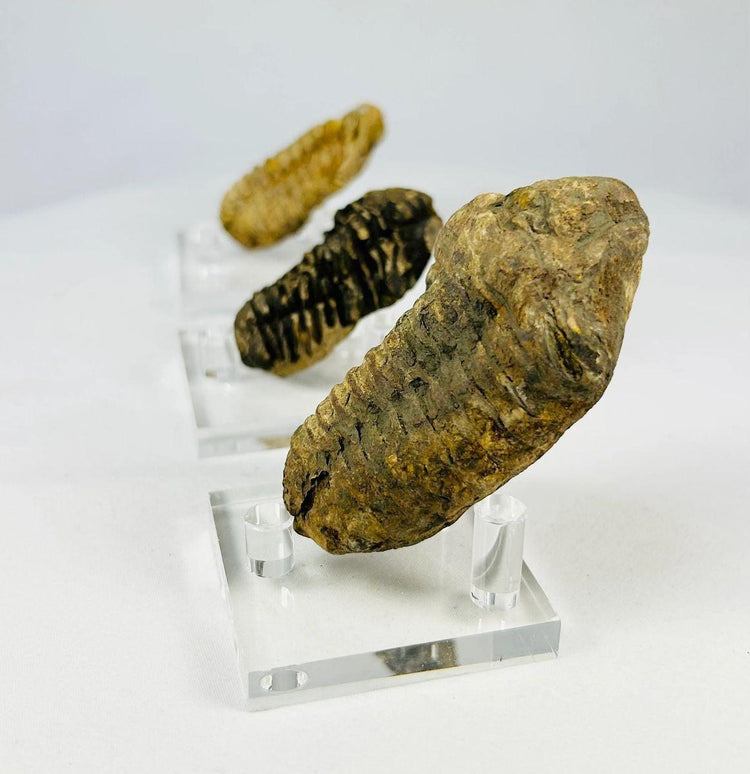Fossilized Trilobite Collection | 400–359 million years ago
Description
More
Less
Historical Context & Origin
Region: Likely North America or Europe (Devonian fossil beds)
Material: Fossilized trilobite exoskeletons preserved in sedimentary stone
Period: Devonian Period, circa 419–359 million years ago
Description
This collection of three trilobite fossils showcases the intricate detail and natural beauty of one of Earth’s earliest and most iconic arthropods. Each specimen demonstrates the classic three-lobed body structure from which trilobites derive their name, consisting of a cephalon (head), thorax, and pygidium (tail). Their exceptional preservation highlights the segmented anatomy that made trilobites highly successful marine organisms for over 270 million years.
-
Specimen 1 (Left): Light tan coloration with a well-defined segmented thorax and a clearly visible cephalon and pygidium. Its symmetry and clean preservation give it strong visual appeal.
-
Specimen 2 (Middle): Darker brown in tone, with sharply pronounced ridges across the thorax and cephalon. The fine segmentation gives this piece a vivid, textured presence.
-
Specimen 3 (Right): Golden-brown hue with a robust exoskeleton and smooth edges, showcasing durability alongside clear anatomical detail.
Features
- Distinct three-lobed trilobite structure clearly visible in each specimen
- Segmented thorax, cephalon, and pygidium preserved with clarity
- Natural coloration ranging from tan to golden brown with earthen tones
- Intricate surface details and mineral patina from millions of years of fossilization
Cultural & Scientific Significance
Trilobites represent one of the earliest complex life forms on Earth and provide invaluable insight into evolutionary biology. As index fossils, they help scientists date and interpret ancient marine strata. Beyond their scientific value, these specimens carry strong aesthetic appeal—each fossil a natural work of art, shaped by time and geology. They remain highly collectible for their combination of educational significance and visual beauty.
Condition
Well-preserved with excellent anatomical detail. Each fossil exhibits natural surface patina, mineral encrustation, and minor imperfections such as small fractures and surface wear, consistent with millions of years of burial. These features enhance their authenticity and add character to the collection.
Dimensions (approximate)
Largest specimen length: 3 in
Age
Estimated 419–359 million years old (Devonian Period)
Description
Historical Context & Origin
Region: Likely North America or Europe (Devonian fossil beds)
Material: Fossilized trilobite exoskeletons preserved in sedimentary stone
Period: Devonian Period, circa 419–359 million years ago
Description
This collection of three trilobite fossils showcases the intricate detail and natural beauty of one of Earth’s earliest and most iconic arthropods. Each specimen demonstrates the classic three-lobed body structure from which trilobites derive their name, consisting of a cephalon (head), thorax, and pygidium (tail). Their exceptional preservation highlights the segmented anatomy that made trilobites highly successful marine organisms for over 270 million years.
-
Specimen 1 (Left): Light tan coloration with a well-defined segmented thorax and a clearly visible cephalon and pygidium. Its symmetry and clean preservation give it strong visual appeal.
-
Specimen 2 (Middle): Darker brown in tone, with sharply pronounced ridges across the thorax and cephalon. The fine segmentation gives this piece a vivid, textured presence.
-
Specimen 3 (Right): Golden-brown hue with a robust exoskeleton and smooth edges, showcasing durability alongside clear anatomical detail.
Features
- Distinct three-lobed trilobite structure clearly visible in each specimen
- Segmented thorax, cephalon, and pygidium preserved with clarity
- Natural coloration ranging from tan to golden brown with earthen tones
- Intricate surface details and mineral patina from millions of years of fossilization
Cultural & Scientific Significance
Trilobites represent one of the earliest complex life forms on Earth and provide invaluable insight into evolutionary biology. As index fossils, they help scientists date and interpret ancient marine strata. Beyond their scientific value, these specimens carry strong aesthetic appeal—each fossil a natural work of art, shaped by time and geology. They remain highly collectible for their combination of educational significance and visual beauty.
Condition
Well-preserved with excellent anatomical detail. Each fossil exhibits natural surface patina, mineral encrustation, and minor imperfections such as small fractures and surface wear, consistent with millions of years of burial. These features enhance their authenticity and add character to the collection.
Dimensions (approximate)
Largest specimen length: 3 in
Age
Estimated 419–359 million years old (Devonian Period)
You May Also Like






















